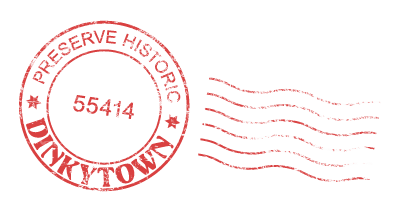Historical Dinkytown
Self-Guided Tour
Dinkytown became an established commercial district in the years between 1899 and 1929, and was a dynamic hotbed of student activism and counterculture through the 1970s. This tour tells the story of Dinkytown as a place where academia and co-ed life spill into the and interact with “real life” that allows new ideas to emerge: The University of Dinkytown.
Annie’s Parlour and Kitty Cat Klub were once known as Perrine’s Books and Art Materials
Introduction
When Minneapolis was established in 1856, the future area that we now call Dinkytown was undeveloped land with an ox cart path and a little creek running though it. Two decisions made in the early years of the area’s settlement set the stage for Dinkytown’s destiny.
First, in 1858, the nascent UofM built it’s Old Main building on a hill on the banks of the Mississippi. Second, the St. Paul & Pacific Railroad (predecessor of the Great Nothern railroad) built the first railroad along the route of the creek on 1862, connecting St. Paul and St. Anthony Falls.
The Grodnik is now home to The Loring.
By the early 1880s, Minneapolis was on its way to becoming the milling capital of the world, the UofM was graduating students with four-year degrees, and the Great Nothern had begun running hourly local trains between Minneapolis and St. Paul, including a station stop for the UofM, the University Station.
“What you learned in Dinkytown is that it is possible to be true to your own passion.”
In 1960, popular Minnesota radio host and author Garrison Keillor attended the UofM as a freshman, and offers this insight on his experience as a Dinkytown regular in those days: Dinkytown was “important as an independent community, tied to the University, serving it, but free and entrepreneurial, and it’s bookstores… coffee house… its odd little shops… were adjuncts of the school and places where students freely mingled with interesting characters, unrecognized intellectuals, free spirits… What you learned in Dinkytown is that it is possible to be true to your own passion.”
Dinkytown was officially designated a Historic District by the City of Minneapolis in 2015.
“this is getting to be a real dinky town!”
Gray’s Drugs and Dinky Town Dime one of many tenants of the Grodnik over the years.
No one knows for sure where the name “Dinkytown” comes from, but there are many theories:
Dinkytown got it’s name because it’s like a small urban village.
The name possibly came from a local merchant who declared one day that “this is getting to be a real dinky town!”
It came from the name of the long-standing dime store in the area, the Dinky Town Dime.
Another theory ties the name to the Grodnik Building, the building in which the Dinky Town Dime was located. “Grodnik” meaning “little village” in Russian.
Another possibility (and the most widely accepted) connects the name to the railroads. “Dinkeys” are small locomotives used for hauling freight, logging, and shunting. Dinkytown was close to the University Station on the Great Northern railroad, which served the UofM and Dinkytown areas. This station may have been known as the “Dinkeytown Station,” but was removed in 1901 and has thus entered history and legend.
Regardless of its origins, the name became official in 1948 when local businessmen formed a group called “The Dinky Town Businessmen’s Association.”
Sandborne map from 1892 depicting what would become the area known as Dinkytown. The rail station is noted on the map.





